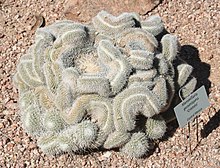Bandage





A fasciation or Fasziation is a rare and usually unusual growth form of plants . The affected plants or parts of plants are usually called comb shapes or cristates . Bandaging has been observed in more than a hundred different plant species. They can occur on all parts of the plant such as roots , shoot axes , leaves , inflorescences , flowers and fruits, both herbaceous and woody plants.
A lattice is very similar to a dichotomous branching , in which the apex cells of a branch divide into two fork branches. In the case of banding, however, the division process remains incomplete, so that the otherwise punctiform cone of vegetation at the tip of the shoot widens linearly. As a result, the following tissue is not cylindrical, as is normally the case, but rather band-shaped or comb-shaped and often twisted due to internal stresses.
Possible triggers of a bandage are damage caused by viruses and phytopathogenic bacteria ( Rhodococcus fascians ), in particular by these plasmids introduced into the plants , fungal infections , mite infestation as well as chemicals , ionizing radiation and spontaneous mutation . Presumably, the stunted growth in the plants caused by the damage invokes an alternative genetic program that switches from the branching through side buds, normal in seed plants, to the original dichotomous branching. But can this z. B. are not fully executed because of genes that have been lost or repurposed in the course of evolution .
Cristat forms are relatively common in highly succulent and only slightly branching plants such as. B. Observe cacti . They occur naturally and, as very large and old specimens show, do not seem to hinder the affected plants. In culture, however, they are often grafted for better preservation and propagation . Sometimes cristates spontaneously develop into normal shoots again. With herbaceous or thin-shoot plants, the association sometimes results in supply problems, so that the cristates dry out after a while. In the case of a cultivated form of the silver fire-head ( Celosia argentea var. Cristata ), the ability to develop banded inflorescences is hereditary and is maintained through breeding work .
Also with inflorescences of the dandelion changes occur unusually often. Both banded inflorescences and several inflorescences of normal shape can occur at the tip of a banded stem axis.
literature
- Gordon Douglas Rowley: Teratopia: The World of Cristate and Variegated Succulents . Cactus & Co, 2006, ISBN 978-88-95018-08-9 .
- Marc C. Albertsen, et al .: Genetics and Comparative Growth Morphology of Fasciation in Soybeans (Glycine max [L.] Merr.) . Botanical Gazette 144 (2): 263-275, 1983.
- AA Sinjushin, SA Gostimsky: Fasciation in pea: Basic principles of morphogenesis . Russian Journal of Developmental Biology 37 (6): 375-381, 2006.
- W. Starke: Development and stabilization of Cristaten . KuaS 20 (3): 83, 1985.
- D. Waldeis: Astrophytum myriostigma -Cristate with over 250 ribs . KuaS 46 (2): 50, 1995.
- N. Boke, R. Ross: Fasciation and dichotomous branching in Echinocereus (Cactaceae) . American Journal of Botany 65 (5): 522-530, 1978.
Web links
- Curtis E. Swift: Fasciation: Fascinating distortions of the plant world. June 18, 2009, accessed October 10, 2012 .